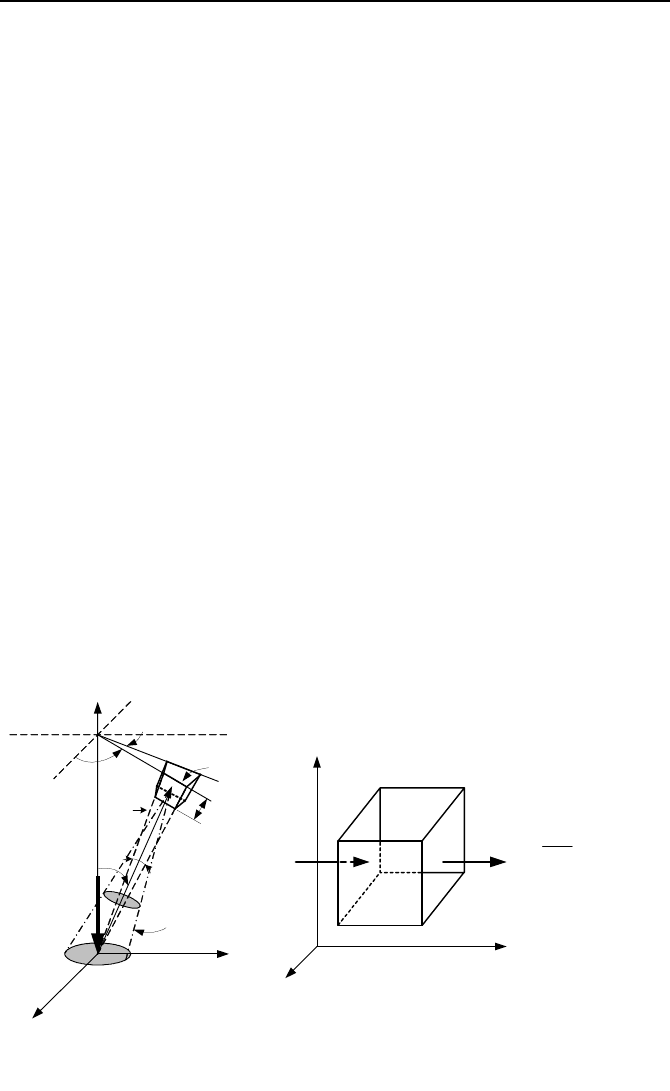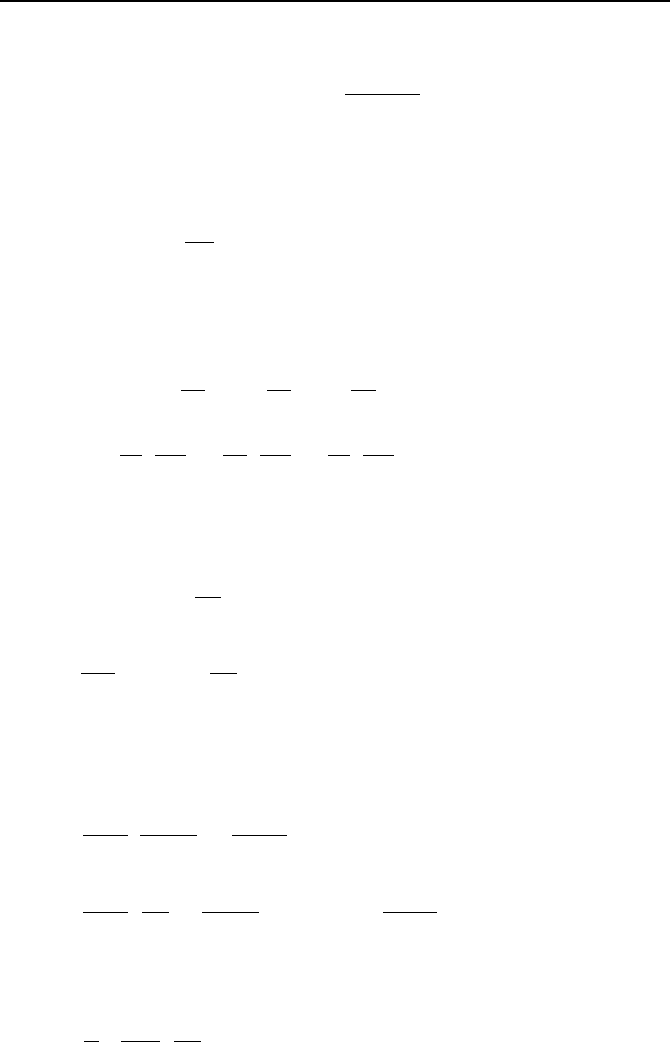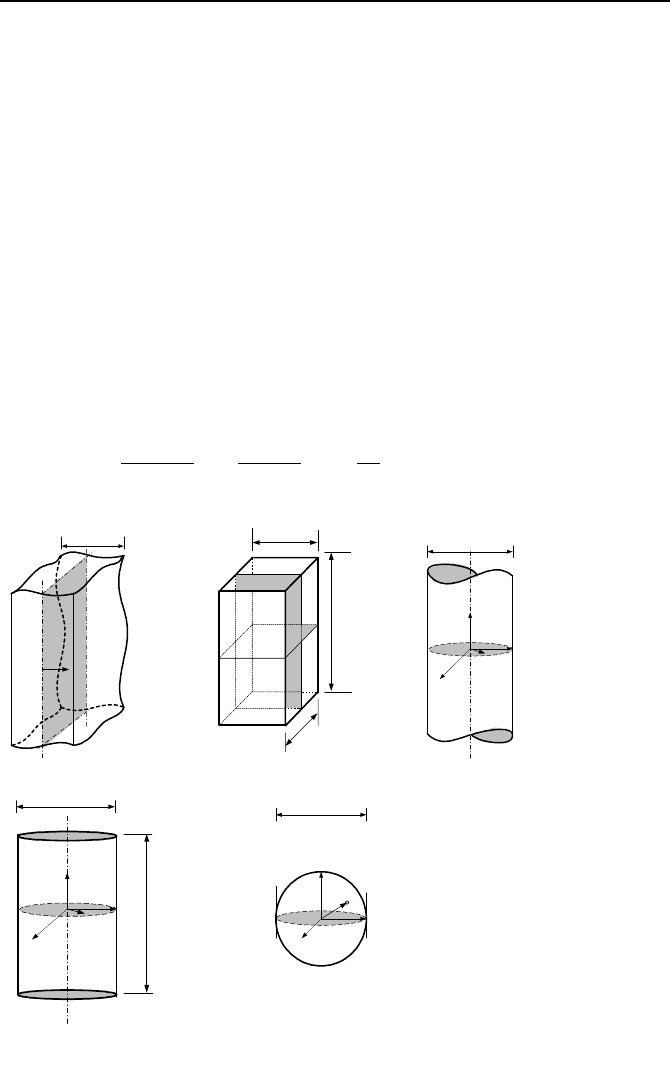Massoud M. Engineering Thermofluids: Thermodynamics, Fluid Mechanics, and Heat Transfer
Подождите немного. Документ загружается.


852 VIe. Applications: Nuclear Heat Generation
The second ratio in Equation VIe.1.7 represents the rate of neutron production due
to thermal fission to the rate of absorption of thermal neutrons:
³
³
³
³
T
T
E
a
fuel
E
f
fuel
ErErd
ErErvd
0
0
),(),(V
),(),(V
fuelinabsorbedneutronsthermalofNo.
fissionthermalinproducedneutronsofNo.
KK
KK
φ
φ
η
Σ
Σ
==
≅
aF
f
v
Σ
Σ
where Σ
aF
is the macroscopic cross section for absorption of the fuel material.
This ratio is referred to as the eta factor. The third ratio in Equation VIe.1.7 is the
rate of thermal neutrons absorbed in the fuel to the rate of thermal neutrons ab-
sorbed in the entire medium:
³
³
³
³
T
T
E
a
medium
E
a
fuel
ErErd
ErErd
f
0
0
),(),(V
),(),(V
mediuminabsorbedneutronsthermalofNo.
fuelinabsorbededneutronsthermalofNo.
KK
K
K
φ
φ
Σ
Σ
==
≅
a
aF
Σ
Σ
where Σ
a
is the macroscopic cross section for absorption of the entire medium.
This ratio is known as the thermal utilization factor. Finally, the last ratio in
Equation VIe.1.7 represents the absorption rate of thermal neutrons to the absorp-
tion rate of all neutrons in the medium:
³
³
³
³
∞
Σ
Σ
==
0
0
),(),(V
),(),(V
mediuminabsoredneutronsallofNo.
mediuminabsorbedneutronsthermalofNo.
ErErd
ErErd
p
a
medium
E
a
medium
T
KK
KK
φ
φ
This ratio is known as the resonance escape probability. Therefore, we can write
the multiplication factor of the infinite medium as k
∞
=
εη
fp. Upon substitution,
the six-factor formula then becomes:
k
eff
=
εη
fpP
FNL
P
TNL
Some one-group key constants for fast reactors are shown in Table VIe.1.3.
Table VIe.1.3 Nominal one-group constants for a fast reactor (Lamarsh)
Cross sections are in barn (i.e., 1E–24 cm
2
)
Element
σ
f
σ
a
σ
tr
v
η
Na 0 0.0008 3.3 – –
Al 0 0.0020 3.1 – –
Fe 0 0.0060 2.7 – –
U-235 1.4 1.6500 6.8 2.6 2.2
U-238 0.095 0.2550 6.9 2.6 0.97
Pu-239 1.85 2.1100 6.8 2.98 2.61

2. Neutron Transport Equation 853
2. Neutron Transport Equation
The neutron transport equation is the mathematical expression of the following
fact:
rate of change of neutron population in a control volume =
rate of neutron appearance in the control volume –
rate of neutron disappearance in the control volume
We now evaluate each term in this neutron balance statement for a differential
control volume dV and integrate over the volume of interest:
– Rate of change of neutron population in a control volume:
()
³
V
V/),,,( ddttErdn Ω
K
K
– Rate of neutron production by the source
*
. If by fission then:
³
³
V
V
V),,,(),(V dtErErvsd
f
ΩΣ=
K
KK
φ
– Rate of neutron production due to scattering from all energy groups and all di-
rections into the differential control volume:
()
[]
³
³
{
}
³
V04
V),(,,, ddEdEEtEr
s
∞
Ω
′′
Ω→Ω
′
→
′
ΣΩ
′′
π
φ
KKK
K
– Rate of net neutron leakage into or out of dV:
()
³
S
dStErJ ⋅Ω,,,
K
K
K
=
()
³
V
V,,, dtErJ Ω⋅∇
K
K
KK
– Rate of neutron scattering out of dV and absorption in dV:
()
()
[
]
³
V
V,,,, ΩΣΩ
K
K
K
K
dEddErtEr
t
φ
where the divergence theorem related the surface to volume integral,
()
[
]
³
()
[
]
³³³
V
V,, dtrJdAntrJ
A
KK
K
K
⋅∇=⋅ . Substituting these in the above statement
for neutron balance and dropping the integral over V, gives:
()()
()
()
()
()( )
³
³
∞
Ω
′′
Ω→Ω
′
→
′
ΣΩ
′′
+ΣΩ=
ΣΩ+Ω⋅∇+
∂
∂
04
,,,,,,,,
,,,,,,,
1
dEdEEtErErtErv
ErtErtErJ
tV
tf
t
π
φφ
φ
φ
KK
KK
K
K
K
K
K
K
K
KK
VIe.2.1
where we also substituted for n in terms of
φ
from Equation VIe.1.4. Equa-
tion VIe.2.1, known as the neutron transport equation, is a linear partial differen-
tial equation. The angular flux in this equation is a function of seven variable;
r
K
(x, y, z), Ω
K
(
θ
,
ϕ
), E, and t. Since both space and time derivatives of the angular
flux, as well as integrals over energy and solid angle, appear together in Equation
VIe.2.1, the neutron transport equation is considered an integrodifferential equa-
tion. Appearance of both flux and current in Equation VIe.2.1 further complicates
finding a solution. It is, therefore, important to find a more useful expression for
*
See Section 2.2 and Problem 42 for the discussion on the type of neutron source.

854 VIe. Applications: Nuclear Heat Generation
θ
d
θ
dr
dV
ϕ
d
ϕ
J
z-
dS
x
r
z
y
dΩ
x
y
z
dz
dy
dx
dy
y
J
J
y
y
∂
∂
+
J
y
(a) (b)
Figure VIe.2.1. (a) Neutron scattering in dV and (b) Neutron leakage from dV
neutron current in terms of neutron flux than the one we already have,
Ω=
KK
φ
J .
Introduction of any type of simplification to allow us deal with Equation VIe.2.1
undoubtedly requires introduction of assumptions. One of the most important as-
sumptions is the scattering-dominant reaction as discussed next.
2.1. Neutron Current In Weakly Absorbing Media
To express neutron current density, appearing in Equation VIe.2.1 in terms of neu-
tron flux, we consider isotropic scattering of neutrons in a weakly absorbing me-
dium. Figure VIe.2.1(a) shows neutrons being scattered isotropically out of the
differential control volume dV. We want to find the neutron current density arriv-
ing at the differential surface dS at the origin located at a distance r from dV. If
the macroscopic scattering of the nuclei located in volume dV is
Σ
s
and the flux of
neutron in dV is
φ
, then the rate of neutrons scattered out of dV in all directions is
(
φ
Σ
s
)dV. Thus, neutrons streaming out of dV are distributed over a sphere cen-
tered at dV at a rate of (
φ
Σ
s
)dV/(4πr
2
). The fraction of these neutrons that should
reach dS at the origin should be [(
φ
Σ
s
)dV/(4πr
2
)]dScos
ϕ
. However, neutron inter-
action with nuclei in the medium attenuates the rate of neutrons (see Problem 30)
arriving at dS by a factor of exp(–
Σr). This factor is the probability of no collision
between position r and the origin. In this relation,
Σ = Σ
a
+ Σ
s
. Since we consid-
ered weakly absorbing medium
Σ
a
§ 0 we may then use Σ § Σ
s
. As a result, the
rate of neutrons arriving per unit area of the differential surface dS at the origin
due to the neutrons streaming out of dV is:
[(
φ
Σ
s
)dV/(4πr
2
)]dScos
ϕ
exp(–Σ
s
r)

2. Neutron Transport Equation 855
The resulting neutron current in the direction shown in Figure VIe.2.1(a) is:
()
2
cos
V
4
s
r
z
zs
dS
dJ dS dJ dS d e
r
ϕ
φ
π
−Σ
−
−
⋅= =Σ
JJG JJG
Substituting for differential volume dV = (dr)(rsin
ϕ
d
θ
)(rd
ϕ
) and integrating, we
get:
2
0
0
0
(, ,) cos sin
4
s
s
z
J
xyze d d dr
π
π
ϕ
θ
φϕϕθϕ
π
∞
−Σ
−
=
=
´
´
´
µ
µ
µ
µ
µ
µ
µ
¶
¶
¶
Σ
ªº
=
¬¼
VIe.2.2
We now expand
φ
(x, y, z) using the Maclaurin series in terms of flux at the origin,
φ
o
=
φ
o
(x
o
, y
o
, z
o
):
22 22 22
222
(, ,)
222
o
oo
o
ooo
xyz x y z
xyz
xyz
xyz
φφφ
φφ
φφφ
§·
∂∂∂
§· §·
=+ + + +
¨¸ ¨¸
¨¸
©¹ ©¹
∂ © ∂ ¹ ∂
§· §· §·
∂∂∂
+++
¨¸ ¨¸ ¨¸
∂∂∂
©¹ ©¹ ©¹
"
Ignoring the higher order terms and substituting flux in Equation VIe.2.2, we ob-
tain:
()
2
/2
0
0
0
2
/2
0
0
0
cos sin
4
cos cos sin
4
s
s
r
s
zo
r
os
Jedddr
re dddr
z
π
π
ϕ
ϑ
π
π
ϕ
θ
φϕϕθϕ
π
φ
ϕϕϕθϕ
π
∞
−Σ
−
=
=
∞
−Σ
=
=
´
´
´
µ
µ
µ
µ
µ
µ
µ
¶
¶
¶
´
´
´
µ
µ
µ
µ
µ
µ
µ
¶
¶
¶
Σ
ªº
=+
¬¼
∂Σ
ªº
¬¼
∂
where we have also substituted for z = rcos
ϕ
and noted that the integral over
x(
∂
φ
/∂x)
o
and y(∂
φ
/∂y)
o
vanishes (see Problem 31). Integrating this equation re-
sults in:
[]
()
[]
/2
2
2
0
0
0
/2
2
2
0
0
0
sin
42
sin
1
43
s
s
r
so
z
s
r
so
s
o
s
e
J
e
r
z
π
π
π
π
φ
ϕ
θ
π
φ
φϕ
θ
π
∞
−Σ
−
∞
−Σ
ªº
ªº
Σ
−
=+
«»
«»
Σ
¬¼
¬¼
ªº
ªº
Σ
∂−
§·
−Σ −
«»
¨¸
«»
©¹
∂Σ
¬¼
¬¼
After the substitution of the integral limits we obtain:
o
s
z
z
J
¸
¹
·
¨
©
§
∂
∂
Σ
+=
−
φφ
6
1
4
VIe.2.3

856 VIe. Applications: Nuclear Heat Generation
In order to find the net current in the z-direction at the origin due to the neutrons
scattered from dV, we also need to find J
z+
. This component is easily obtained by
integrating Equation VIe.2.4 for
π
/2 ≤
ϕ
≤
π
:
o
s
z
z
J
¸
¹
·
¨
©
§
∂
∂
Σ
−=
+
φφ
6
1
4
VIe.2.4
Thus the net neutron current at the origin in the z-direction becomes:
o
s
zzz
z
JJJ
¸
¹
·
¨
©
§
∂
∂
Σ
−=−=
−+
φ
3
1
VIe.2.5
Similar analyses can be performed for the x and y directions. Thus the total neu-
tron current becomes:
¸
¸
¹
·
¨
¨
©
§
∂
∂
+
∂
∂
+
∂
∂
Σ
−=
zyx
J
s
φφφ
3
1
VIe.2.6
Note that in Equation VIe.2.6 we dropped subscript o (i.e., the reference to the ori-
gin). This is because we can carry out similar analyses for any other point, taken
as the origin of the coordinate system, in space. We may further simplify
Equation VIe.2.6 as:
() ()()
ErrDErJ ,,
K
K
KK
K
φ
∇−= VIe.2.7
where D in Equation VIe.2.7, is known as the diffusion coefficient (Table VIe.1.2)
and is given by D = 1/3
Σ
s
. Recall that we derived Equation VIe.2.7 assuming iso-
tropic scattering in a weakly absorbing medium. We may still apply Equation
VIe.2.7 to cases where scattering is not isotropic by including the mass number of
the moderating nuclei and using D = A/(3A + 2)
Σ
s
. In a homogeneous medium Σ
s
and D are constant values independent of location. Thus Equation VIe.2.7 in the
thermal region, for example, simply becomes
() ()
rDrJ
K
K
K
K
φ
∇−= . This is known
as Fick’s law expressing the fact that in weakly absorbing media, the current of
neutrons is from the highly populated region to the sparsely populated region sim-
ply due to the net diffusion of the neutrons.
2.2. The One-Speed Neutron Diffusion Equation
The neutron diffusion equation may be obtained from the neutron transport equa-
tion or derived directly by applying the balance of neutrons for the control volume
of Figure VIe.2.1(b). Choosing the latter method, we find the net rate of leakage
into the differential volume in the y-direction as:
() ()
dxdydz
y
J
dxdzdy
y
J
JdxdzJ
yy
yy
∂
∂
−=
»
¼
º
«
¬
ª
∂
∂
+−

2. Neutron Transport Equation 857
Adding the leakage terms in the x- and z- directions, we find the total leakage for
the control volume dV as
J
KK
⋅∇− . Thus the rate of change of neutrons in the
control volume, (1/V)(
∂
φ
/∂t) is equal to the rate of production from a neutron
source such as s and the net in-leakage minus the net absorption or removal. Ex-
pressed mathematically;
),()(),(),(
),(1
trrtrJtrs
t
tr
V
a
KKK
KK
K
K
φ
φ
Σ−⋅∇−=
∂
∂
VIe.2.8
Substituting for the neutron current density from Fick’s law given by Equa-
tion VIe.2.7, we find:
[]
)],()([),()(),(
),(1
trrDtrrtrs
t
tr
V
a
K
K
K
K
KKK
K
φφ
φ
∇−⋅∇+Σ−=
∂
∂
VIe.2.9
Expectedly, Equation VIe.2.9 is similar to Equation IVa.2.1 as it was derived for
diffusion of heat in solids. For a homogeneous medium, D can be treated as a
constant and the diffusion equation is obtained as:
),(),()(),(
),(1
2
trDtrrtrs
t
tr
V
a
KKKK
K
φφ
φ
∇+Σ−=
∂
∂
VIe.2.10
Note that in the derivation of the neutron diffusion equation we assumed that the
flux of neutrons is isotropic (i.e., with no directional preference), otherwise the
diffusion model does not apply. For example, while the diffusion model is appli-
cable in water, it breaks down at the water-air boundary. This is due to the fact
that water is much denser than air hence more neutrons move from water to air
than from air to water. If we are interested only in the steady state solution, the
diffusion equation further simplifies to:
)()()(
2
rsrrD
a
KKK
−=Σ−∇
φφ
VIe.2.11
In Equation VIe.2.11, the Laplacian operator for a rectangular parallelepiped, a
cylinder, or a sphere is given by Equation VIIc.1.9, VIIc.1.10, or VIIc.1.11, re-
spectively. For example, neutron flux in a slab is only a function of x, thus Equa-
tion VIe.2.11 simplifies to:
D
xs
x
D
dx
xd
a
)(
)(
)(
2
2
−=
Σ
−
φ
φ
VIe.2.12
Since
Σ
a
/D is referred to as the diffusion area L
2
= Σ
a
/D then L is known as the dif-
fusion length. In cylindrical coordinates, assuming flux varies only in the r-
direction, Equation VIe.2.11 simplifies to:
D
rs
r
Ddr
rd
r
dr
d
r
a
)(
)(
)(1
−=
Σ
−
»
¼
º
«
¬
ª
φ
φ
VIe.2.13

858 VIe. Applications: Nuclear Heat Generation
and in spherical coordinates, assuming flux varies only in the r-direction, Equa-
tion VIe.2.11 becomes:
D
rs
r
Ddr
rd
r
dr
d
r
a
)(
)(
)(1
2
2
−=
Σ
−
»
¼
º
«
¬
ª
φ
φ
VIe.2.14
To find neutron flux we need two boundary conditions for the second order differ-
ential equation VIe.2.11. These boundary conditions depend not only on the ge-
ometry of the medium but also on the type of the neutron source. These are dis-
cussed next.
Medium geometry: The simplest geometry for Equations IVe.2.11 through
IVe.2.14 is an infinite medium. Other geometries include infinite slab, finite slab,
parallelepiped, infinite cylinder, finite cylinder, and sphere.
Type of source: Neutron sources may be of flux-dependent or flux-indepen-
dent types. Flux dependent sources are due to fission. Flux-independent sources
are sources that emit neutrons at a constant rate and are the driving force for the
existence of neutron flux in a medium such as a moderator. The flux-independent
sources may either be of a localized or distributed type. We can find analytical so-
lutions for flux-independent sources of point, line, or planar types located in a
sphere, cylinder, or slab (See Problems 32 through 41). If we are solving Equa-
tions VIe.2.11 through VIe.2.14 for flux-independent localized sources, s in these
equations should be set to zero, as the neutron source would appear in the bound-
ary condition.
Type of boundary condition: If we are dealing with an infinite medium, one
boundary condition is obtained by the fact that as the variable approaches infinity,
the flux must become zero. On the other hand, if we are dealing with finite me-
dium, the flux must be zero at the extent of the medium.
The second boundary condition is obtained from the type of the neutron source.
For example, the neutron current is generally known as the independent variable
approaches the source. For a distributed neutron source, we can take advantage of
symmetry if the source is distributed uniformly. If a medium is one that is cov-
ered by a blanket, also known as a reflector (see Problem 35), then at the interface
between two regions A and B, we must satisfy:
φ
A
=
φ
B
& nJnJ
BA
K
K
⋅=⋅ VIe.2.15
For the continuity of current in a reflected slab, for example;
–D
A
(∂
φ
A
/∂x)
boundary
= –D
B
(∂
φ
B
/∂x)
boundary
For flux-dependent distributed sources, where the neutron flux and the neutron
source are intertwined, we can write:
φηφη
a
a
aF
aF
s Σ
Σ
Σ
=Σ=
=
φη
a
fΣ

3. Determination of Neutron Flux in an Infinite Cylindrical Core 859
where f, the fuel utilization factor, is simply given as
aaF
f ΣΣ= / and the multi-
plication factor k
∞
:
φ
φ
η
a
a
f
k
Σ
Σ
=
∞
Table VIe.1.3 gives useful data such as
σ
f
,
σ
a
, v, and
η
for various materials,
where
η
is the average number of fission neutrons emitted per neutron absorbed.
Substituting k
ũ
into the diffusion equation, we find:
φ
2
∇D –
φ
a
Σ = –
φ
a
k Σ
∞
Dividing through by the diffusion coefficient, we get:
φ
2
∇ +
φ
)1( −
Σ
∞
k
D
a
= 0
Defining L
2
= D/Σ
a
as the diffusion area, we find:
φ
2
∇ +
φ
2
B = 0 VIe.2.16
where B
2
= (k
∞
– 1)/L
2
is known as Material Buckling. Equation VIe.2.16 is a
one-group (i.e., one-energy group) diffusion equation. We can express the one
group diffusion equation for a variety of sources such as infinite planar source,
point source, and bare slab. However, we are more interested in reactor cores hav-
ing such familiar geometries as parallelepiped, cylindrical, and spherical. All we
need to do is to express the Laplacian operator for the specified core geometry as
discussed next.
3. Determination of Neutron Flux in an Infinite Cylindrical Core
Since the cylindrical geometry is most applicable to actual reactor cores, we begin
with an infinite circular cylinder and then reduce the solution to the finite right
circular cylinder.
Flux in infinite cylindrical core. An infinite cylindrical core is a theoretical
concept. We analyze it to eliminate the variation of neutron flux in the z-direction,
which will be considered later. Assuming symmetry in the
θ
-direction, neutron
flux becomes only a function of r. The diffusion equation then becomes:
2
1()
() 0
ddr
rBr
rdr dr
φ
φ
§·
+=
¨¸
©¹
If we compare this equation with Equation VIIb.1.13, we note that we are dealing
with a Bessel differential equation of order zero (v = 0) with m also being zero.
The solution is given by Equation VIIb.1.14:

860 VIe. Applications: Nuclear Heat Generation
φ
= c
1
J
0
(Br)+c
2
Y
o
(Br)
where we must find constants c
1
and c
2
from the following boundary conditions:
at r = 0,
φ =
finite and at r = R,
φ
≅ 0
From the first boundary condition and Figure VIIb.3.1, we conclude that c
2
= 0
hence,
φ
= c
1
J
o
(Br). The second boundary condition is even more interesting, as
we get a host of answers. Figure VIIb.3.1 shows that function J
o
(x) goes to zero
for three values of x when x ranges only from 0 to 8. This indicates that we are
dealing with a Sturm-Liouville problem. The diffusion equation is a boundary-
value problem having two homogenous boundary conditions. The Sturm-
Liouville problem is discussed in Chapter VIIb. Hence, from the second boundary
condition we find the n answers that satisfy the secondary boundary conditions as:
B
n
R = x
n
where x
n
stands for all n zeros of J
o
(x), the Bessel function of the first kind of or-
der zero. As seen from Figure VIIb.3.1, the first zero occurs at 2.405. Hence, B
1
R
= 2.405 and B
1
= 2.405/R. Thus the flux becomes:
φ
= c
1
J
o
¸
¹
·
¨
©
§
R
r
405.2
Although we were not able to find c
1
, we managed to find the square root of the
buckling term. To find coefficient c
1
, we use the power produced by the reactor.
The power produced per unit volume is given by Equation VIe.1.5 as
q
′′′
= E
R
φ
Σ
f
.
Thus, power produced by a unit length of the infinite cylinder reactor is found as:
()
0
V
11
0
0
( ) V ( )(2 )
2.405 2.405
(2 ) 2
R
RR
ff
R
R
oo
RR
ff
QE d E rdr
rr
E
c J rdr c E J rdr
RR
φφπ
ππ
´´
µµ
¶¶
´
´
µ
µ
µ
µ
µ
µ
µ
¶
¶
ªº
§· §·
«»
¨¸ ¨¸
©¹ ©¹
«»
¬¼
=Σ= Σ
=Σ=Σ
In Chapter VIIb the above integral is carried out so that:
()
1
0
0
2
2
11
2.405 2.405
2.405
0.51911
2.405 0 (0) 0.2158
2.405 2.405
rR
R
o
r
rR r
JrdrrJ
RR
RR
R
JJ R
=
=
´
µ
µ
¶
ªº
§· §·
=
¨¸ ¨¸
«»
©¹ ©¹
¬¼
= ª −× º ==
¬¼
Substituting for the integral and solving for c
1
, neutron flux distribution in an infi-
nite cylinder core becomes:
φ
=
fR
RE
Q
Σ
2
1.356
J
o
¸
¹
·
¨
©
§
R
r
405.2
VIe.3.1

3. Determination of Neutron Flux in an Infinite Cylindrical Core 861
x
L
1
L
1
H
L
2
2R
r
H
r
2R
H/2
-H/2
z
r
2R
Figure VIe.3.1. Infinite slab, rectangular parallelepiped, infinite cylinder, finite cylinde
r
and sphere
Flux in a finite cylinder core. Having solved the infinite cylinder core, we
may apply the same method of solution to other geometries such as an infinite slab,
rectangular parallelepiped or a spherical core. The results for all these cases are
summarized in Table VIe.3.1. Note that the solution for a rectangular parallelepi-
ped is obtained from the solution for an infinite slab. Similarly, the solution for a
finite cylinder is obtained from the solutions for an infinite slab and an infinite cyl-
inder. This is the same method we used for the determination of temperature dis-
tribution in these geometries, as shown in Table IVa.9.2. The reason for the simi-
larity in mathematical solution is the fact that diffusion is the mechanism for both
heat and flux transfer. As seen from Table VIe.3.1, for a finite cylinder, which re-
sembles actual nuclear reactor cores, neutron flux varies as a cosine function in the
axial and as the Bessel function of the first kind of order zero in the radial direction.
Hence, maximum flux occurs in the center of the reactor. As will be discussed later
in this chapter, neutron flux should be as uniform as possible in nuclear reactors. In
practice this goal is approached by variety of means including the arrangement of
higher power fuel assemblies in the core periphery. From Table VIe.3.1, neutron
flux in a finite cylinder and homogenous core is then given as:
φ
(r, z) =
¸
¸
¹
·
¨
¨
©
§
Σ
fR
E
Q
V
63.3
J
o
¸
¹
·
¨
©
§
R
r
405.2
cos
¸
¹
·
¨
©
§
H
z
π
VIe.3.2
